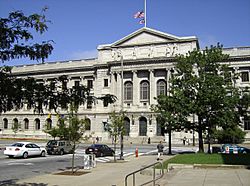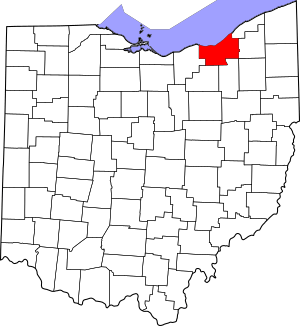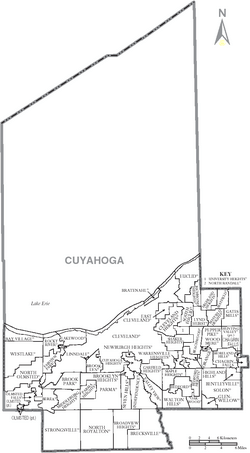Cuyahoga County, Ohio facts for kids
Quick facts for kids
Cuyahoga County
|
|||
|---|---|---|---|

|
|||
|
|||
| Etymology: Cuyahoga River | |||

Map of Cuyahoga County within Ohio
|
|||
| Country | United States | ||
| State | Ohio | ||
| Region | Northeast Ohio | ||
| Founded | May 1, 1810 | ||
| Named for | Cuyahoga River | ||
| County seat | Cleveland | ||
| Area | |||
| • Total | 1,246 sq mi (3,230 km2) | ||
| • Land | 457 sq mi (1,180 km2) | ||
| • Water | 788 sq mi (2,040 km2) | ||
| Elevation | 653 ft (199 m) | ||
| Population
(2020)
|
|||
| • Total | 1,264,817 | ||
| • Estimate
(2023)
|
1,233,088 |
||
| • Density | 2,768/sq mi (1,069/km2) | ||
| Gross Domestic Product | |||
| • Total | US$104.292 billion (2022) | ||
| Time zone | UTC−5 (EST) | ||
| • Summer (DST) | UTC−4 (EDT) | ||
| Area code(s) | 216 | ||
| Congressional districts | 7th, 11th | ||
| Largest city | Cleveland | ||
Cuyahoga County is a big county in the northeastern part of Ohio, a state in the United States. A county is like a large region within a state, with its own local government.
The main city and county seat is Cleveland. In 2020, over 1.2 million people lived here. This makes it the second most populated county in Ohio.
Cuyahoga County is located right on the southern shore of Lake Erie. The Cuyahoga River flows through the county and is where the county gets its name. The word "Cuyahoga" comes from an old Native American language, and it means "crooked river."
Contents
History of Cuyahoga County
The land that is now Cuyahoga County was once part of a French colony called New France. In 1763, it became part of Great Britain.
Later, in the 1790s, this land was part of the Connecticut Western Reserve. This was a piece of land that the state of Connecticut claimed. The Connecticut Land Company bought it in 1795.
The city of Cleveland was started in 1796 by General Moses Cleaveland. It was built near where the Cuyahoga River meets Lake Erie.
Cuyahoga County was officially created on June 7, 1807. It started its government on May 1, 1810. Cleveland was chosen as the county seat in 1809. Over time, parts of Cuyahoga County were used to create other nearby counties like Huron, Lake, and Lorain counties.
Did you know that James A. Garfield, who later became a U.S. President, was born in what was then Orange Township in Cuyahoga County in 1831?
Geography of Cuyahoga County
Cuyahoga County covers about 1,246 square miles. About 457 square miles of this is land, and a large part, 788 square miles, is water. This makes it the second-largest county in Ohio by total area.
A part of the beautiful Cuyahoga Valley National Park is located in the southeastern section of the county.
Counties Next to Cuyahoga
- Lake County (to the northeast)
- Geauga County (to the east)
- Summit County (to the southeast)
- Medina County (to the southwest)
- Lorain County (to the west)
- Portage County (also to the southeast)
People in Cuyahoga County
| Historical population | |||
|---|---|---|---|
| Census | Pop. | %± | |
| 1810 | 1,459 | — | |
| 1820 | 6,328 | 333.7% | |
| 1830 | 10,373 | 63.9% | |
| 1840 | 26,506 | 155.5% | |
| 1850 | 48,099 | 81.5% | |
| 1860 | 78,033 | 62.2% | |
| 1870 | 132,010 | 69.2% | |
| 1880 | 196,943 | 49.2% | |
| 1890 | 309,970 | 57.4% | |
| 1900 | 439,120 | 41.7% | |
| 1910 | 637,425 | 45.2% | |
| 1920 | 943,495 | 48.0% | |
| 1930 | 1,201,455 | 27.3% | |
| 1940 | 1,217,250 | 1.3% | |
| 1950 | 1,389,532 | 14.2% | |
| 1960 | 1,647,895 | 18.6% | |
| 1970 | 1,721,300 | 4.5% | |
| 1980 | 1,498,400 | −12.9% | |
| 1990 | 1,412,140 | −5.8% | |
| 2000 | 1,393,978 | −1.3% | |
| 2010 | 1,280,122 | −8.2% | |
| 2020 | 1,264,817 | −1.2% | |
| 2023 (est.) | 1,233,088 | −3.7% | |
| U.S. Decennial Census 1790-1960 1900–1990 1990–2000 2010–2020 |
|||
In 2020, about 1,264,817 people lived in Cuyahoga County. The county is home to many different groups of people. About 56.8% of the people were White, and 28.9% were Black or African American. About 3.5% were Asian, and 6.6% were Hispanic or Latino.
About 20.3% of the people living in the county were under 18 years old. Also, 19.6% were 65 years or older.
Education in Cuyahoga County
Cuyahoga County has many places for learning, from schools for kids to universities for older students.
Colleges and Universities
Here are some of the higher-education schools in Cuyahoga County:
- Baldwin Wallace University (in Berea)
- Case Western Reserve University (in Cleveland)
- Cleveland Institute of Art (in Cleveland)
- Cleveland State University (in Cleveland)
- Cuyahoga Community College (with campuses in Cleveland, Highland Hills, Westlake, and Parma)
- John Carroll University (in University Heights)
- Ursuline College (in Pepper Pike)
Schools for Kids (K-12)
Many different school districts serve the children in Cuyahoga County. Some of these include:
- Bay Village City School District
- Beachwood City School District
- Cleveland Municipal School District
- Cleveland Heights-University Heights City School District
- Euclid City School District
- Lakewood City School District
- Parma City School District
- Shaker Heights City School District
- Solon City School District
- Westlake City School District
Getting Around in Cuyahoga County
There are many ways to travel in and out of Cuyahoga County, including airports, major roads, and public transportation.
Airports
The county has several airports, including:
- Cuyahoga County Airport
- Cleveland Hopkins International Airport (a large airport in Cleveland)
- Cleveland Burke Lakefront Airport (in Cleveland, right by Lake Erie)
Major Roads
Many important highways run through Cuyahoga County, connecting it to other parts of Ohio and the country.
 I-71
I-71 I-77
I-77
 I-80 / Ohio Turnpike
I-80 / Ohio Turnpike I-90
I-90 I-271
I-271 I-480
I-480 US 6
US 6 US 20
US 20 US 42
US 42 SR 2
SR 2 SR 3
SR 3 SR 8
SR 8 SR 10
SR 10
Trains
You can take Amtrak passenger trains from Cleveland's Lakefront Station to cities like Chicago, New York, and Boston.
The Cuyahoga Valley Scenic Railroad offers fun train rides through the beautiful Cuyahoga Valley National Park.
Public Transportation
The Greater Cleveland Regional Transit Authority, also known as RTA, helps people get around Cuyahoga County. They offer buses and train services.
You can also take long-distance buses like Greyhound to travel to other states.
Fun Things to Do in Cuyahoga County
Cuyahoga County has many parks and cultural spots for everyone to enjoy.
Parks and Green Spaces
The Cleveland Metroparks system has 16 different park areas. These parks offer over 21,000 acres of green space and places for outdoor activities. Part of the Cuyahoga Valley National Park is also in the county, offering even more nature to explore.
Theaters
If you like plays and shows, there are many theaters:
- Beck Center (in Lakewood)
- Cleveland Play House (in Cleveland)
- Playhouse Square Center (in Cleveland, a very large theater complex)
Music
- The Cleveland Orchestra performs classical music in Severance Hall.
Museums
Cuyahoga County has many interesting museums:
- Cleveland Museum of Art
- Rock and Roll Hall of Fame (a famous museum about music)
- Cleveland Museum of Natural History
- Great Lakes Science Center (a fun place for science experiments)
Communities in Cuyahoga County
Cuyahoga County is made up of many different cities, villages, and townships.
Cities
Villages
Townships
- Chagrin Falls
- Olmsted
See also
 In Spanish: Condado de Cuyahoga para niños
In Spanish: Condado de Cuyahoga para niños





